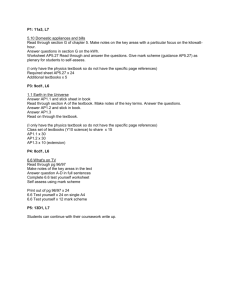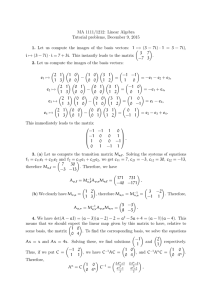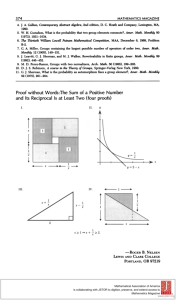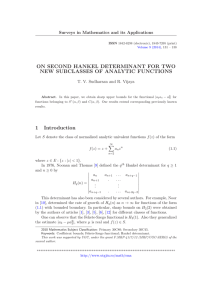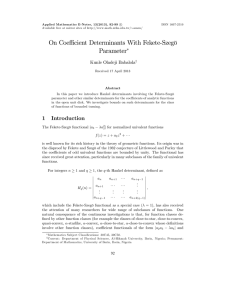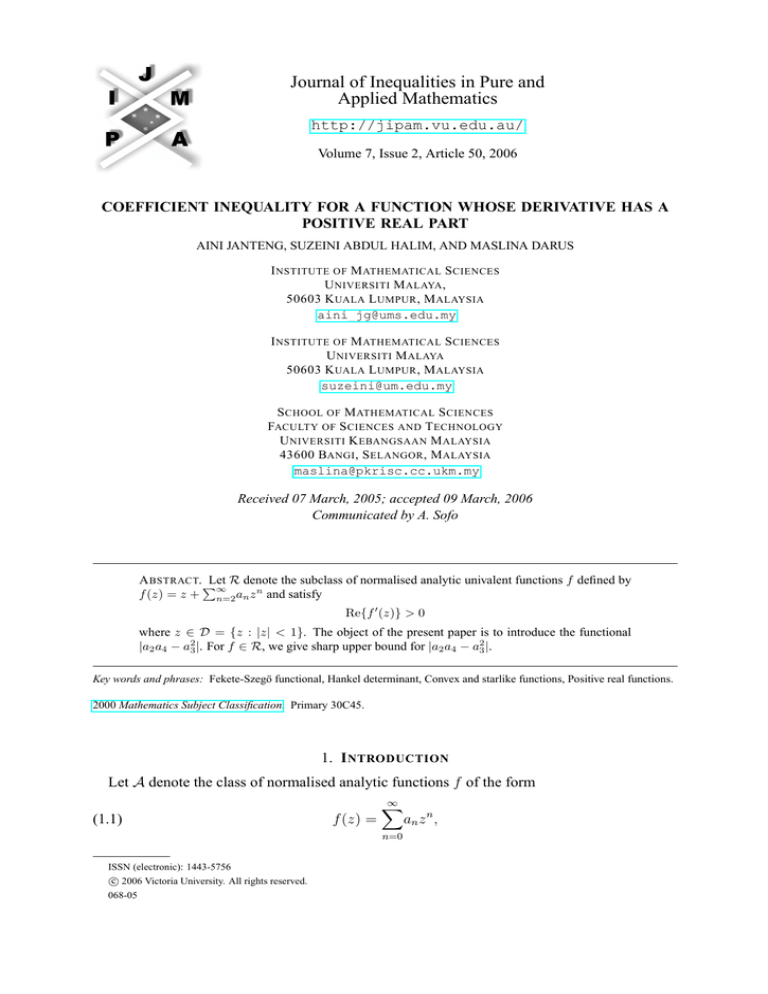
Journal of Inequalities in Pure and
Applied Mathematics
http://jipam.vu.edu.au/
Volume 7, Issue 2, Article 50, 2006
COEFFICIENT INEQUALITY FOR A FUNCTION WHOSE DERIVATIVE HAS A
POSITIVE REAL PART
AINI JANTENG, SUZEINI ABDUL HALIM, AND MASLINA DARUS
I NSTITUTE OF M ATHEMATICAL S CIENCES
U NIVERSITI M ALAYA ,
50603 K UALA L UMPUR , M ALAYSIA
aini_jg@ums.edu.my
I NSTITUTE OF M ATHEMATICAL S CIENCES
U NIVERSITI M ALAYA
50603 K UALA L UMPUR , M ALAYSIA
suzeini@um.edu.my
S CHOOL OF M ATHEMATICAL S CIENCES
FACULTY OF S CIENCES AND T ECHNOLOGY
U NIVERSITI K EBANGSAAN M ALAYSIA
43600 BANGI , S ELANGOR , M ALAYSIA
maslina@pkrisc.cc.ukm.my
Received 07 March, 2005; accepted 09 March, 2006
Communicated by A. Sofo
A BSTRACT. P
Let R denote the subclass of normalised analytic univalent functions f defined by
∞
f (z) = z + n=2 an z n and satisfy
Re{f 0 (z)} > 0
where z ∈ D = {z : |z| < 1}. The object of the present paper is to introduce the functional
|a2 a4 − a23 |. For f ∈ R, we give sharp upper bound for |a2 a4 − a23 |.
Key words and phrases: Fekete-Szegö functional, Hankel determinant, Convex and starlike functions, Positive real functions.
2000 Mathematics Subject Classification. Primary 30C45.
1. I NTRODUCTION
Let A denote the class of normalised analytic functions f of the form
(1.1)
f (z) =
∞
X
n=0
ISSN (electronic): 1443-5756
c 2006 Victoria University. All rights reserved.
068-05
an z n ,
2
A INI JANTENG , S UZEINI A BDUL H ALIM ,
where z ∈ D = {z : |z| < 1}. In [9],
determinant of f is defined for q ≥ 1 by
an
an+1
Hq (n) = ..
.
a
n+q−1
AND
M ASLINA DARUS
Noonan and Thomas stated that the qth Hankel
an+1 · · · an+q+1
an+2 · · · an+q+2
..
..
..
.
.
.
an+q · · · an+2q−2
.
Now, let S denote the subclass of A consisting of functions f of the form
f (z) = z +
(1.2)
∞
X
an z n
n=2
which are univalent in D.
A classical theorem of Fekete and Szegö [1] considered the Hankel determinant of f ∈ S for
q = 2 and n = 1,
a1 a2 .
H2 (1) = a2 a3 They made an early study for the estimates of |a3 − µa22 | when a1 = 1 and µ real. The wellknown result due to them states that if f ∈ S, then
4µ − 3,
if µ ≥ 1,
−2µ
2
|a3 − µa2 | ≤
1 + 2 exp 1−µ
, if 0 ≤ µ ≤ 1,
3 − 4µ,
if µ ≤ 0.
Hummel [3, 4] proved the conjecture of V. Singh that |a3 − a22 | ≤ 13 for the class C of convex
functions. Keogh and Merkes [5] obtained sharp estimates for |a3 − µa22 | when f is close-toconvex, starlike and convex in D.
Here, we consider the Hankel determinant of f ∈ S for q = 2 and n = 2,
a2 a3 .
H2 (2) = a3 a4 Now, we are working on the functional |a2 a4 − a23 |. In this earlier work, we find a sharp upper
bound for the functional |a2 a4 − a23 | for f ∈ R. The subclass R is defined as the following.
Definition 1.1. Let f be given by (1.2). Then f ∈ R if it satisfies the inequality
(1.3)
Re{f 0 (z)} > 0,
(z ∈ D).
The subclass R was studied systematically by MacGregor [8] who indeed referred to numerous earlier investigations involving functions whose derivative has a positive real part.
We first state some preliminary lemmas which shall be used in our proof.
2. P RELIMINARY R ESULTS
Let P be the family of all functions p analytic in D for which Re{p(z)} > 0 and
(2.1)
p(z) = 1 + c1 z + c2 z 2 + · · ·
for z ∈ D.
Lemma 2.1 ([10]). If p ∈ P then |ck | ≤ 2 for each k.
J. Inequal. Pure and Appl. Math., 7(2) Art. 50, 2006
http://jipam.vu.edu.au/
C OEFFICIENT I NEQUALITY
3
Lemma 2.2 ([2]). The power series for p(z) given in (2.1) converges in D to a function in P if
and only if the Toeplitz determinants
2
c1
c2
· · · cn c−1
2
c1
· · · cn−1 (2.2)
Dn = ..
n = 1, 2, 3, . . .
..
..
..
.. ,
.
.
.
.
. c
2 −n c−n+1 c−n+2 · · ·
P
itk
and c−k = c̄k , are all nonnegative. They are strictly positive except for p(z) = m
k=1 ρk p0 (e z),
ρk > 0, tk real and tk 6= tj for k 6= j; in this case Dn > 0 for n < m − 1 and Dn = 0 for
n ≥ m.
This necessary and sufficient condition is due to Carathéodory and Toeplitz and can be found
in [2].
3. M AIN R ESULT
Theorem 3.1. Let f ∈ R. Then
4
|a2 a4 − a23 | ≤ .
9
The result obtained is sharp.
Proof. We refer to the method by Libera and Zlotkiewicz [6, 7]. Since f ∈ R, it follows from
(1.3) that
f 0 (z) = p(z)
(3.1)
for some z ∈ D. Equating coefficients in (3.1) yields
2a2 = c1
3a3 = c2 .
(3.2)
4a = c
4
3
From (3.2), it can be easily established that
c1 c3 c22 |a2 a4 −
=
− .
8
9
c2 We make use of Lemma 2.2 to obtain the proper bound on c18c3 − 92 . We may assume without
restriction that c1 > 0. We begin by rewriting (2.2) for the cases n = 2 and n = 3.
2 c1 c2 D2 = c1 2 c1 = 8 + 2 Re{c21 c2 } − 2|c2 |2 − 4c21 ≥ 0,
c̄2 c1 2 a23 |
which is equivalent to
2c2 = c21 + x(4 − c21 )
(3.3)
for some x, |x| ≤ 1. Then D3 ≥ 0 is equivalent to
|(4c3 − 4c1 c2 + c31 )(4 − c21 ) + c1 (2c2 − c21 )2 | ≤ 2 4 − c21
2
2
− 2 2c2 − c21 ;
and this, with (3.3), provides the relation
(3.4)
4c3 = c31 + 2(4 − c21 )c1 x − c1 (4 − c21 )x2 + 2(4 − c21 )(1 − |x|2 )z,
for some value of z, |z| ≤ 1.
J. Inequal. Pure and Appl. Math., 7(2) Art. 50, 2006
http://jipam.vu.edu.au/
4
A INI JANTENG , S UZEINI A BDUL H ALIM ,
AND
M ASLINA DARUS
Suppose, now, that c1 = c and c ∈ [0, 2]. Using (3.3) along with (3.4) we get
c1 c3 c22 c4
c2 (4 − c2 )x (4 − c2 )(32 + c2 )x2 c(4 − c2 )(1 − |x|2 )z −
+
8 − 9 = 288 +
144
288
16
and an application of the triangle inequality shows that
c1 c3 c22 (3.5)
8 − 9
c4
c(4 − c2 ) c2 (4 − c2 )ρ (c − 2)(c − 16)(4 − c2 )ρ2
+
+
+
288
16
144
288
= F (ρ)
≤
with ρ = |x| ≤ 1. We assume that the upper bound for (3.5) attains at the interior point of
ρ ∈ [0, 1] and c ∈ [0, 2], then
c2 (4 − c2 ) (c − 2)(c − 16)(4 − c2 )ρ
+
.
144
144
We note that F 0 (ρ) > 0 and consequently F is increasing and M axρ F (ρ) = F (1), which
contadicts our assumption of having the maximum value at the interior point of ρ ∈ [0, 1]. Now
let
c(4 − c2 ) c2 (4 − c2 ) (c − 2)(c − 16)(4 − c2 )
c4
+
+
+
,
G(c) = F (1) =
288
16
144
288
then
−c(5 + c2 )
=0
G0 (c) =
36
implies c = 0 which is a contradiction. Observe that
F 0 (ρ) =
−5 − 3c2
< 0.
36
Thus any maximum points of G must be on the boundary of c ∈ [0, 2]. However, G(c) ≥ G(2)
and thus G has maximum value at c = 0. The upper bound for (3.5) corresponds to ρ = 1 and
c = 0, in which case
c1 c3 c22 4
8 − 9 ≤ 9.
Equality is attained for functions in R given by
G00 (c) =
f 0 (z) =
1 + z2
.
1 − z2
This concludes the proof of our theorem.
R EFERENCES
[1] M. FEKETE AND G. SZEGÖ, Eine Bemerkung uber ungerade schlichte funktionen, J. London
Math. Soc., 8 (1933), 85–89.
[2] U. GRENANDER AND G. SZEGÖ, Toeplitz Forms and their Application, Univ. of California Press,
Berkeley and Los Angeles, (1958)
[3] J. HUMMEL, The coefficient regions of starlike functions, Pacific J. Math., 7 (1957), 1381–1389.
[4] J. HUMMEL, Extremal problems in the class of starlike functions, Proc. Amer. Math. Soc., 11
(1960), 741–749.
[5] F.R. KEOGH AND E.P. MERKES, A coefficient inequality for certain classes of analytic functions,
Proc. Amer. Math. Soc., 20 (1969), 8–12.
J. Inequal. Pure and Appl. Math., 7(2) Art. 50, 2006
http://jipam.vu.edu.au/
C OEFFICIENT I NEQUALITY
5
[6] R.J. LIBERA AND E.J. ZLOTKIEWICZ, Early coefficients of the inverse of a regular convex function, Proc. Amer. Math. Soc., 85(2) (1982), 225–230.
[7] R.J. LIBERA AND E.J. ZLOTKIEWICZ, Coefficient bounds for the inverse of a function with
derivative in P, Proc. Amer. Math. Soc., 87(2) (1983), 251–289.
[8] T.H. MACGREGOR, Functions whose derivative has a positive real part, Trans. Amer. Math. Soc.,
104 (1962), 532–537.
[9] J.W. NOONAN AND D.K. THOMAS, On the second Hankel determinant of areally mean p-valent
functions, Trans. Amer. Math. Soc., 223(2) (1976), 337–346.
[10] CH. POMMERENKE, Univalent Functions, Vandenhoeck and Ruprecht, Göttingen, (1975)
J. Inequal. Pure and Appl. Math., 7(2) Art. 50, 2006
http://jipam.vu.edu.au/

